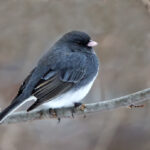Cape May is well known for its ghost tours and haunted Victorian lore—but you don’t have to wait until Halloween to go searching for ghosts. Visit the beach after sundown, and you might encounter a different kind of phantom: the elusive Atlantic Ghost Crab (Ocypode quadrata), scurrying across the sand.
These charismatic crabs are common inhabitants of Cape May’s beaches and are equipped with some fascinating adaptations. Their name—ghost crab—is fitting, not just for their nocturnal nature, but for their pale, sand-colored shells and sudden, swift movements. Adult ghost crabs measure about 2–3 inches across and have semi-translucent bodies that blend seamlessly into the beach environment. Juveniles are even better camouflaged, with speckled markings that help them disappear into the sand.


Watching a ghost crab dart sideways and suddenly vanish into a burrow is like witnessing a magic trick. These burrows can be several feet deep, offering shelter from predators and harsh conditions. Though they spend much of their time underground, ghost crabs emerge to feed, mate, and wet their gills at the water’s edge. Younger crabs tend to build their burrows closer to the surf, minimizing the danger during their excursions. Interestingly, they can draw moisture from damp sand using specialized hairs on their legs—sometimes eliminating the need to visit the ocean entirely.
Ghost crabs have long, stalked eyes that swivel, providing them with nearly panoramic vision—ideal for spotting predators, prey, and potential mates. They are omnivorous and opportunistic, feeding on marine insects, organic debris, eggs, and even smaller crabs. But they are prey themselves, often hunted by shorebirds, gulls, and raccoons. Capable of moving in any direction at speeds of up to 10 miles per hour, ghost crabs can make a quick getaway when threatened. If an intruder nears their burrow, they may even produce a rasping sound—known as stridulation—by rubbing parts of their claw together as a warning.
Even if you’re just enjoying a daytime stroll along the beach, you can spot evidence of ghost crabs. Look for round holes in the sand—these are entrances to their burrows. The size of the hole often matches the size of the crab, and you may see delicate tracks nearby that resemble rows of commas.
For a more immersive experience, join the Nature Center of Cape May’s “Nighttime on the Beach” program. Every Thursday at 8 p.m., participants gather at the end of Mt. Vernon Avenue to explore the beach after dark. Guided by a naturalist, the walk begins with insights into the moon, tides, bats, moths, and other nocturnal creatures. As twilight fades, the beach comes alive with movement. Armed with flashlights and the humorously named “Ghost Crab Catcher 5000,” participants of all ages chase after the scuttling crabs. Each catch is handled gently and respectfully before the crabs are released back into the night.
Whether you’re a curious visitor or a local looking for a new way to experience Cape May, this unique nighttime adventure offers a fun, educational glimpse into the lively, lesser-seen world of the beach after dark.
To register for Nighttime on the Beach with the Nature Center of Cape May, visit njaudubon.org/calendar or call (609) 427-4045.
Emily Reed is the Interim Director of New Jersey Audubon’s Nature Center of Cape May.








